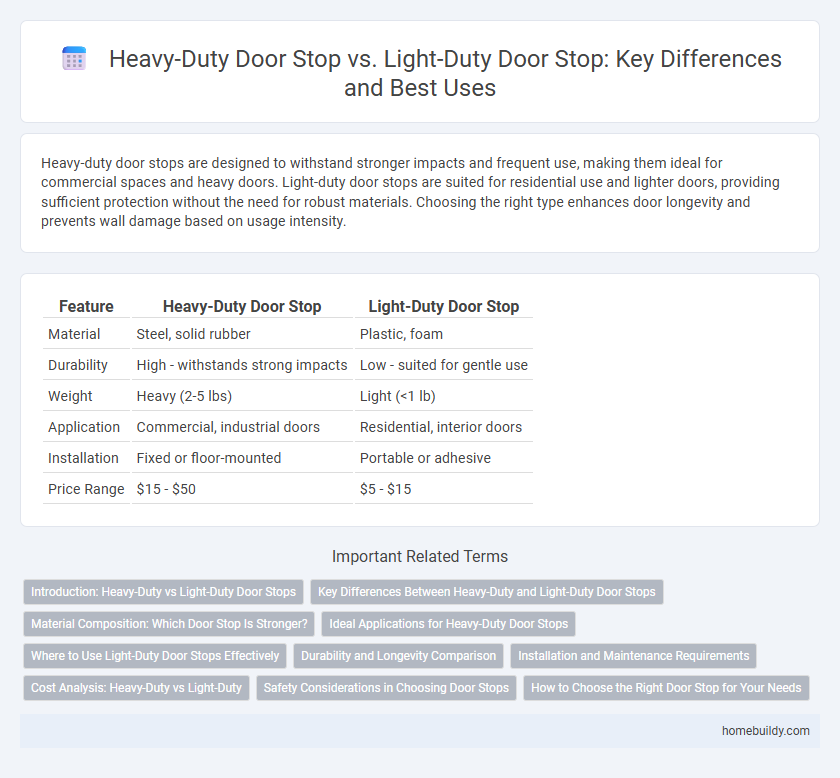Heavy-duty door stops are designed to withstand stronger impacts and frequent use, making them ideal for commercial spaces and heavy doors. Light-duty door stops are suited for residential use and lighter doors, providing sufficient protection without the need for robust materials. Choosing the right type enhances door longevity and prevents wall damage based on usage intensity.
Table of Comparison
| Feature | Heavy-Duty Door Stop | Light-Duty Door Stop |
|---|---|---|
| Material | Steel, solid rubber | Plastic, foam |
| Durability | High - withstands strong impacts | Low - suited for gentle use |
| Weight | Heavy (2-5 lbs) | Light (<1 lb) |
| Application | Commercial, industrial doors | Residential, interior doors |
| Installation | Fixed or floor-mounted | Portable or adhesive |
| Price Range | $15 - $50 | $5 - $15 |
Introduction: Heavy-Duty vs Light-Duty Door Stops
Heavy-duty door stops are engineered for high-traffic areas and commercial applications, offering superior strength and durability to withstand frequent impact. Light-duty door stops are designed for residential use, providing adequate protection for doors in low-traffic environments with materials that prioritize ease of installation and cost-effectiveness. Choosing between heavy-duty and light-duty door stops depends on the specific requirements for durability, frequency of use, and environmental conditions.
Key Differences Between Heavy-Duty and Light-Duty Door Stops
Heavy-duty door stops are designed with robust materials like steel or solid aluminum, providing superior durability and resistance to frequent impact, making them ideal for commercial or high-traffic areas. Light-duty door stops typically use softer materials such as rubber or plastic, suitable for residential use where door impact is less intense and occasional. Key differences include load capacity, material strength, and intended environment, with heavy-duty models offering enhanced stability and wear resistance while light-duty options emphasize affordability and ease of installation.
Material Composition: Which Door Stop Is Stronger?
Heavy-duty door stops are typically made from robust materials such as solid steel, cast iron, or reinforced rubber, offering superior strength and durability for withstanding heavy impact and frequent use. Light-duty door stops often use materials like plastic or lightweight aluminum, which provide less resistance and are best suited for minimal force applications. The material composition directly determines the door stop's ability to endure pressure and maintain functionality, making heavy-duty options stronger and more reliable for high-traffic or commercial environments.
Ideal Applications for Heavy-Duty Door Stops
Heavy-duty door stops are ideal for industrial settings, commercial buildings, and high-traffic areas where frequent door impact and strong resistance are required. Designed to withstand significant force, these door stops protect walls and doors from damage caused by heavy doors or equipment, ensuring long-term durability and safety. Their robust construction is suitable for warehouse entrances, emergency exits, and heavy metal or wooden doors that demand reliable performance.
Where to Use Light-Duty Door Stops Effectively
Light-duty door stops are ideal for interior doors in residential or office environments where minimal force is applied, such as bedroom or bathroom doors. These stops effectively prevent wall damage and reduce door hardware wear without requiring robust materials. Their lightweight design ensures easy installation on drywall or wooden surfaces, making them best suited for light-traffic areas.
Durability and Longevity Comparison
Heavy-duty door stops are crafted from robust materials like steel or solid rubber, offering superior durability and a longer lifespan under frequent or forceful use compared to light-duty door stops, which typically use softer plastics or lighter metals prone to wear and damage. The enhanced construction of heavy-duty models ensures resistance to impacts, moisture, and temperature fluctuations, preserving their functionality over time. Light-duty door stops are suitable for low-traffic areas but often require more frequent replacement due to their limited strength and durability.
Installation and Maintenance Requirements
Heavy-duty door stops require more secure installation methods such as anchoring into concrete or solid wood to handle greater force and frequent use, whereas light-duty door stops typically use adhesive or simple screw mounts suitable for lighter doors and less intensive applications. Maintenance for heavy-duty stops involves regular inspection of mounting hardware and cleaning to prevent wear from high-impact resistance, while light-duty stops need minimal upkeep, often limited to occasional cleaning and adhesive checks. Choosing the appropriate door stop depends on the door's usage frequency and force, ensuring installation and maintenance efforts match the durability requirements.
Cost Analysis: Heavy-Duty vs Light-Duty
Heavy-duty door stops typically cost between $15 and $40 due to durable materials like steel or solid rubber, offering long-term value in high-traffic areas. Light-duty door stops range from $5 to $15, made from plastic or foam, suitable for low-traffic environments but with shorter lifespan and frequent replacement costs. Evaluating total cost of ownership, heavy-duty options provide better durability and fewer replacements, while light-duty stops offer lower upfront expense but higher maintenance over time.
Safety Considerations in Choosing Door Stops
Heavy-duty door stops are designed to withstand significant force and prevent doors from slamming, making them essential for high-traffic or commercial environments where safety hazards are prevalent. Light-duty door stops offer adequate protection for residential settings with minimal impact risk but may fail under heavy use, potentially causing door damage or injury. Selecting the appropriate door stop based on load capacity and application reduces accidents and enhances overall safety protocols.
How to Choose the Right Door Stop for Your Needs
Heavy-duty door stops are designed for high-traffic areas or doors exposed to strong force, offering robust materials like steel or solid rubber to prevent damage and ensure durability. Light-duty door stops suit residential or low-traffic environments, typically made from softer materials like plastic or lightweight metal, providing adequate protection without excessive strength. Choosing the right door stop depends on factors such as door weight, frequency of use, and installation location to balance functionality and longevity.
Heavy-Duty Door Stop vs Light-Duty Door Stop Infographic

 homebuildy.com
homebuildy.com